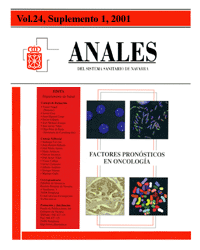Prognostic factors in brain tumours
DOI:
https://doi.org/10.23938/ASSN.0434Keywords:
Tumores cerebrales. Glioma maligno. Factores pronósticos. Quimioterapia. Radioterapia.Abstract
Primary brain tumours cause approximately 2% of deaths from cancer. In spite of this relatively low mortality rate, cerebral tumours produce a great emotional impact on the patient and his family because of their particular natural history. It is characterised by an almost universal tendency of the high grade gliomas (the most frequent) to local relapse after surgery followed by radiotherapy (with or without chemotherapy), and the subsequent clinical progression with progressive disability of the patient until his death. The malignant gliomas (multiform glioblastoma, anaplastic astrocytoma and anaplastic oligodendroglioma) are the most frequent cerebral tumours in the adult (apart from cerebral metastasis), and constitute a challenge to the oncologist facing the scarce improvement in survival obtained by complementary radiotherapy and chemotherapy. In this article we review the most relevant prognostic factors in malignant gliomas, paying special attention to the molecular prognostic factors. This is a basic area of knowledge that is undergoing increasing expansion, which in the hopefully not to distant future might offer new therapeutic treatments that will radically change the grim prognosis of this disease.Downloads
Downloads
Published
How to Cite
Issue
Section
License
La revista Anales del Sistema Sanitario de Navarra es publicada por el Departamento de Salud del Gobierno de Navarra (España), quien conserva los derechos patrimoniales (copyright ) sobre el artículo publicado y favorece y permite la difusión del mismo bajo licencia Creative Commons Reconocimiento-CompartirIgual 4.0 Internacional (CC BY-SA 4.0). Esta licencia permite copiar, usar, difundir, transmitir y exponer públicamente el artículo, siempre que siempre que se cite la autoría y la publicación inicial en Anales del Sistema Sanitario de Navarra, y se distinga la existencia de esta licencia de uso.








